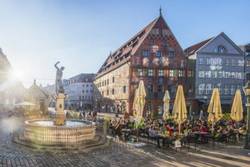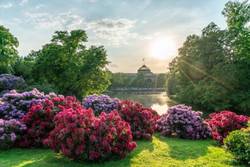

WASSER is the central Conference for the water industry in Germany and the annual conference of the Society of Water Chemistry. Professionals and experts from all areas of water chemistry, water treatment, and other disciplines meet every year in May at various locations for an intensive exchange of experiences and ideas. A focus of the Conference is on personal encounters and scientific discussions on current technical challenges.
To celebrate the 100th anniversary of the Division , the Society of Water Chemistry returns to its founding location: the city of Kiel.
website
The university city of Münster in western Germany is known for its bicycle-friendly cityscape, making it one of the major centers of the state of North Rhine-Westphalia. With its 320,000 inhabitants, it is one of the major centers of the state of North Rhine-Westphalia. A well-known landmark is the 13th-century St. Paul's Cathedral, which features Gothic and Romantic elements. Lake Aasee, located in the immediate vicinity of the WASSER 2025 venue, is a reservoir that, together with the surrounding meadows and forests, is considered an inner-city recreational area. (Photo: © Stadtmarketing Münster)
program
Limburg an der Lahn is the district capital of the Limburg-Weilburg district in central Hesse. Together with the neighboring Rhineland-Palatinate town of Diez, it forms a cross-state dual center with approximately 47,000 inhabitants. Due to its location, Limburg serves as a hub for the sparsely populated western part of Hesse, as well as for parts of the Westerwald district and the Rhein-Lahn district in Rhineland-Palatinate. Limburg is best known for its cathedral and picturesque half-timbered old town. Located directly on the Lahn River, water has always played a central role in Limburg. From the old Lahn Bridge, you can see the mighty old Dome of the Rock with its towers. This is also home to Germany's only surviving bridge tower from the 14th century. (Photo: © Stadtmarketing Limburg)

program
After three years of abstinence, during which in-person exchange was not possible, the annual conference of the Society of Water Chemistry was once again held as an in-person event in the water city of Augsburg. Augsburg, a vibrant city with Italian flair and a zest for life, is one of the most important economic centers in Bavaria with a population of around 300,000. The city's history has been shaped by water over the centuries. With the "Augsburg Water Management System," Augsburg has been a UNESCO World Heritage Site since 2019, making it a perfect venue for our annual conference. The historic city center offers much more than just the Renaissance town hall with its Golden Hall or the Perlach Tower. The power of the Fugger family and their global fame can still be felt here. (Photo: © Regio Augsburg Tourismus GmbH)

program
With a heavy heart, to avoid all risks and ensure planning security, the Board decided to hold the event Online once again due to the pandemic situation. The decision to postpone the conference planning for Wiesbaden had to be made at a time when it was unclear how the situation would develop by May. (Photo: © wiesbaden.de, Martin Kunz)
program
Due to the ongoing pandemic, the German Chemical Society (GDCh) had to cancel all in-person events for the second year in a row. Since this was foreseeable, an alternative concept in the form of an Online event was developed in parallel in advance, which reflected many fundamental elements of the annual conference. (Photo: © TMB photo archive, Steffen Lehmann, SPSG)
Due to the coronavirus pandemic, the annual meeting planned for Potsdam had to be canceled at short notice. It was a bitter blow for everyone involved to have to cancel an annual meeting of the Society of Water Chemistry for the first time since 1948. (Photo: © Pixabay_neufal54)
The 2019 annual conference took place in Erfurt, the beautiful state capital of Thuringia. With its approximately 213,000 inhabitants, the state metropolis, as the "gateway" to Thuringia, is one of the most attractive university, trade fair, and conference locations. The city of Luther, the cathedral, and the flower city, can look back on a rich history spanning over 1,250 years. The cityscape is characterized by one of the best-preserved medieval old town centers in Germany. Originally built at the crossroads of important trade routes, Erfurt is not only an architectural gem but also the center of a cultural landscape that has evolved over centuries. (Photo: © ETMG, Barbara Neumann)
In 2018, the water chemistry convened for its 84th annual conference in Papenburg, the so-called "Venice of the North." Germany's longest and oldest fen colony (moor settlement), with its 37,000 inhabitants, is located in northern Emsland, in the immediate vicinity of East Frisia and the Netherlands. Water as the source of all life – once again, we encounter the reference to the main element of the Society of Water Chemistry, which laid the foundation for the city's development: In the 1630s, the city's founder, Dietrich von Velen, built the first canals to drain the moor and subsequently extract peat, which could be delivered by ship to the East Frisian brickworks. Today, Papenburg is also associated with the construction of impressive cruise ships. (Photo: © Papenburg Marketing, Ute Müller)
program
The 83rd Annual Conference took place in Donaueschingen. The residence of the Princes of Fürstenberg, with its approximately 23,000 inhabitants, is ideally located on the edge of the Southern Black Forest and close to Lake Constance, the Swabian Alb, and Switzerland. The Donauhallen offered first-class facilities for the requirements of the water Conference . Water as the source of all life – rarely has the connection to the main element of the Society of Water Chemistry been as clear as in Donaueschingen. While the larger headwaters, the Breg at the St. Martin's Chapel near Furtwangen, are the hydrological source, the headwaters of the Donaubach in Donaueschingen are symbolically considered the source of the Danube. About two kilometers east of the city, it joins the Brigach and Breg, the eponymous beginning of the Danube, to form a single great river. From here, the Danube begins its long journey to the Black Sea, uniquely connecting the diverse cultures of Europe from west to east. (Photo: © City of Donaueschingen, Tobias Raphael Ackermann)
program
"Wasser 2016" took place in Bamberg from May 2nd to 4th, 2016. This year's event was hosted by the Welcome Kongresshotel Bamberg. Founded in 1007 by Emperor Henry II, this Upper Franconian bishopric on the Regnitz River now has a population of approximately 70,000. The old imperial and episcopal city is distinguished as a prosperous business location and a young university city with a rich cultural life. With the largest intact old town center in Europe, Bamberg has been a UNESCO World Heritage Site since 1993. (Photo: © Press Office of the City of Bamberg)
program
In 2015, the 81st Annual Meeting of the Society of Water Chemistry opened its doors in Schwerin, the "City of Seven Lakes and Forests." Schwerin and water are inextricably linked—reason enough to hold the annual meeting here. 245 participants registered, who were offered 23 presentations and 81 posters. (Photo: © Stadtmarketing GmbH Schwerin)
1926: Kiel, 1927: Essen, 1928: Dresden, 1929: Breslau, 1930: Frankfurt, 1931: Vienna, 1932: Essen, 1933: Würzburg, 1934: Cologne, 1935: Königsberg, 1936: Munich, 1937: Frankfurt, 1938: Bayreuth, 1944: Weimar, 1948: Hanover, 1949: Munich, 1950: Frankfurt, 1951: Essen, 1952: Bad Homburg, 1953: Hamburg, 1954: Bad Dürkheim, 1955: Frankfurt am Main, 1956: Konstanz, 1957: Goslar, 1958: Bad Nauheim, 1959: Kiel, 1960: Lindau, 1961: Würzburg, 1962: Fulda, 1963: Berlin, 1964: Bad Wiessee, 1965: Timmendorfer Strand, 1966: Bamberg, 1967: Bad Driburg, 1968: Bad Ems, 1969: Bad Dürrheim, 1970: Bad Nenndorf, 1971: Bad Reichenhall, 1972: Marburg, 1973: Bad Zwischenahn, 1974: Konstanz, 1975: Bad Kissingen, 1976: Kiel, 1977: Berlin, 1978: Obersdorf, 1979: Bad Pyrmont, 1980: Trier, 1981: Hinterzarten, 1982: Garmisch-Partenkirchen, 1983: Norderney, 1984: Bad Homburg, 1985: Bad Füssing, 1986: Wildbad, 1987: Bad Harzburg, 1988: Bad Neuenahr, 1989: Hindelang, 1990: Timmendorfer Strand, 1991: Bad Kissingen, 1992: Dresden, 1993: Badenweiler, 1994: Coburg, 1995: Hitzacker, 1996: Koblenz, 1997: Lindau, 1998: Lübeck, 1999: Regensburg, 2000: Weimar, 2001: Bad Wildungen, 2002: Eichstätt/Altmühltal, 2003: Stade, 2004: Bad Saarow, 2005: Bad Mergentheim, 2006: Celle, 2007: Passau, 2008: Trier, 2009: Stralsund, 2010: Bayreuth, 2011: Norderney, 2012: Neu-Ulm, 2013: Goslar, 2014: Haltern, 2015: Schwerin, 2016: Bamberg, 2017: Donaueschingen, 2018: Papenburg, 2019: Erfurt, 2020: canceled (planned for Potsdam; Corona), 2021: online (Corona), 2022: online (Corona), 2023: Augsburg, 2024: Limburg (Lahn), 2025: Münster, 2026: Kiel
This page has been machine translated. If you have any feedback or comments please feel free to contact us. 
last modified: 09.09.2025 14:24 H from C.Kniep